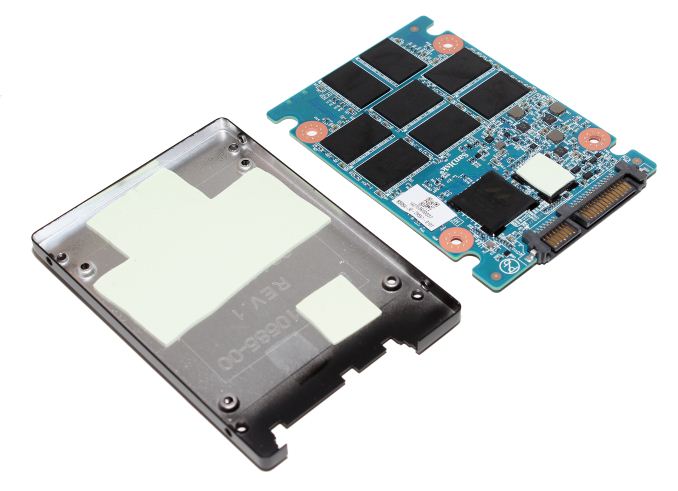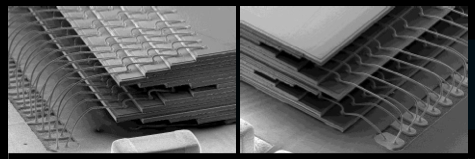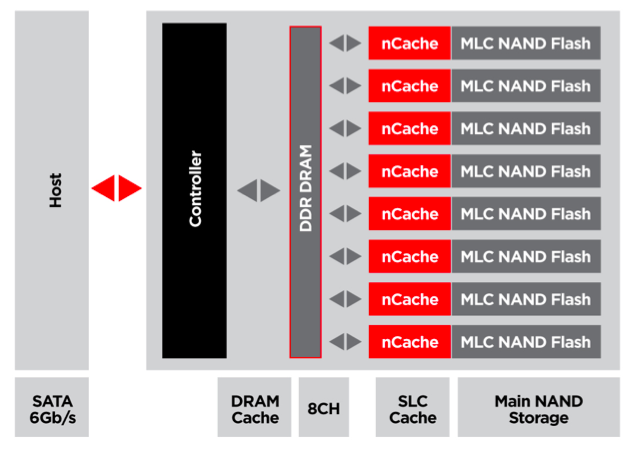SanDisk Extreme Pro SSD (240GB, 480GB & 960GB) Review: The Fastest Just Got Faster
by Kristian Vättö on June 16, 2014 4:00 PM EST- Posted in
- Storage
- SSDs
- SanDisk
- Extreme Pro

The SSD market is currently going through the biggest change in its history. Ever since consumer SSDs started appearing around 2006, SATA has been the dominant interface but now that is about to change. With PCIe and NVMe making their way to the consumer space, SATA will sooner than later become obsolete, at least for high performance SSDs.
But right now, it is way too early to bury SATA. The transition to PCIe has taken its first baby steps but is far from taking over SATA. I believe 2015 will be the year of PCIe SSDs, because by then we will have several PCIe SSD platforms ready from SandForce, JMicron, and others; then the OEMs can start shipping drives in volume. However, we are still six months away from 2015 and even then, SATA is not going anywhere. The market and drives will continue to evolve and the latest proof comes from SanDisk with a humble name: the Extreme Pro.
The Extreme Pro takes the proven recipe of the Extreme II. The controller is unchanged but the firmware has been optimized even further for consistency and the NAND has been changed to SanDisk's own second generation 64Gbit 19nm MLC (same as Toshiba's A19nm). SanDisk's target markets for the Extreme Pro are gamers and professionals, which are user groups that traditionally crave performance and consistency.
The Extreme II had excellent IO consistency to begin with and was one of the most consistent client drives we have tested, so the bar is set high for the Extreme Pro. SanDisk is so confident about the reliability of the Extreme Pro that it is giving it a 10-year warranty, which is twice of what any consumer-grade SSD has offered so far.
| SanDisk Extreme Pro Specifications | |||
| Capacity | 240GB | 480GB | 960GB |
| Controller | Marvell 88SS9187 | ||
| NAND | SanDisk 2nd Generation 64Gbit 19nm MLC | ||
| DRAM | 512MB | 1GB | 1GB |
| Sequential Read | 550MB/s | 550MB/s | 550MB/s |
| Sequential Write | 520MB/s | 515MB/s | 515MB/s |
| 4KB Random Read | 100K IOPS | 100K IOPS | 100K IOPS |
| 4KB Random Write | 90K IOPS | 90K IOPS | 90K IOPS |
| Idle Power (DevSLP/Slumber) | 5.5mW / 82.5mW | 19mW / 100mW | 19mW / 100mW |
| Load Power (Read/Write) | 2.7W / 2.6W | 2.7W / 3.5W | 2.9W / 3.6W |
| Endurance | 80TB (~22GB per day for 10 years) | ||
| Encryption | No | ||
| Warranty | 10 years | ||
SanDisk dumps the 120GB model from the Extreme Pro lineup but adds a 960GB one. This move makes sense because 120GB cannot provide the same level of performance due to the lack of NAND but also falling NAND prices have made 1TB-class SSDs affordable for consumers. I am a bit surprised that SanDisk has decided to use 64Gbit parts in all models because usually 1TB-class SSDs have required the use of bigger 128Gbit dies. I guess it helps that the page size is 16KB for the 64Gbit part too because the main problem with high capacity SSDs is that when you double the capacity, the amount of pages you need to track doubles as well. With both 64Gbit and 128Gbit parts having the same page size, the issue is pretty much neutralized as long as the controller and firmware can talk to that many NAND die (this is where having your own firmware team helps).
Photography by Juha Kokkonen
The PCB in the Extreme Pro is single-sided in all models. There are eight NAND packages, which means that the 960GB drive must be using 16-die packages to achieve such high capacity. 16-die packages are actually nothing new because SanDisk and others have used them, and even 32-die packages, in memory cards for quite some time.
SanDisk's 16-die package used in 128GB iSSD
However, the yields are lower because it takes more precision to stack 16 dies and connect all the wires, which is why most manufacturers only use 8-die packages in SSDs. For memory cards one NAND package is enough because there is no space for more, but SSDs need several packages. Yields do get better over time though, and SanDisk's 16-die packaging is apparently economical enough to be used in SSDs now. There are some latency obstacles as well because taller stacks require longer wires, but it looks like the drawback is not enough to prevent their use in high performance SSDs.
| NAND Configurations | |||
| Capacity | 240GB | 480GB | 960GB |
| Raw NAND Capacity | 256GiB | 512GiB | 1024GiB |
| Over-Provisioning | 12.7% | 12.7% | 12.7% |
| # of NAND Packages | 8 | 8 | 8 |
| # of Die per Package | 4x8GB | 8x8GB | 16x8GB |
The endurance remains unchanged from the Extreme II despite the doubled warranty. While 80TB should be enough for most users, I still would have liked to see higher endurance with the longer warranty. I think that the 10-year warranty is there just to differentiate the drive for marketing reasons, because if the Extreme Pro is used in (for example) professional video editing for ten years, the 80TB rating, or about 22GB a day, will not be sufficient. It appears SanDisk is betting that its target users will either replace the drive within a few years or the endurance limit will be hit after the warranty runs out, meaning that the 10-year warranty may not actually add any concrete value to the end-user. Of course it can still offer peace of mind for replacement drives, but I would give more value to the endurance rating when comparing high-end SSDs.
The Extreme Pro features a more advanced version of SanDisk's nCache SLC caching technology, called nCache Pro. The difference between the two is that the original nCache was mainly for the firmware and NAND mapping table caching for data integrity reasons (it's faster to write to the SLC portion in case of a sudden power loss) but the nCache Pro is more optimized for user data caching. SanDisk would not reveal the exact size of the SLC buffer but SanDisk did tell us that it is less than 1GB, which is quite small compared to Samsung's TurboWrite with up to 12GB of SLC cache. That makes me think that the purpose of nCache Pro is to act more as a DRAM-like cache instead of a performance buffer, because ultimately you want to store as little data as possible in the DRAM due to its volatility.
SanDisk still does DRAM caching too, but writes smaller than 4KB will be cached to the SLC cache. Most writes from the host are 4KB in size but those are also tricky for the SSD because page sizes are much larger than that (currently 16KB), so caching to the faster and more durable SLC portion makes sense for write-combining (i.e. wait for more small IOs to come in and then write them as 16KB to the MLC part). Traditionally write-combining is done in the DRAM but it is much safer to do that in the SLC buffer, because the data will still be safe after a power loss whereas with DRAM it would be gone. (Of course, a super capacitor design could protect data in the event of a power failure.)
Sadly there is no encryption support. I asked why in our meeting at Computex and SanDisk told me that because TCG Opal 2.0 is still relatively new, SanDisk wanted to roll it out with the lower volume X300s first and see how the market reacts. SanDisk argued that it did not see the need for that in the Extreme Pro because they view desktop users as the main market, although I disagreed because the popularity of mobile workstations and laptop-as-desktop setups is constantly increasing, such that good IO performance should not only be limited to desktop users. In addition, I think desktop users, especially in the enthusiast and professional crowd, would appreciate encryption support because the data they handle can be sensitive (such as in home clouds). Hopefully we will see proper encryption support in the next generation drive (or even better: through a firmware update) because it is a quite significant drawback in the Extreme Pro.
Test System
| CPU | Intel Core i5-2500K running at 3.3GHz (Turbo and EIST enabled) |
| Motherboard | AsRock Z68 Pro3 |
| Chipset | Intel Z68 |
| Chipset Drivers | Intel 9.1.1.1015 + Intel RST 10.2 |
| Memory | G.Skill RipjawsX DDR3-1600 4 x 8GB (9-9-9-24) |
| Video Card | Palit GeForce GTX 770 JetStream 2GB GDDR5 (1150MHz core clock; 3505MHz GDDR5 effective) |
| Video Drivers | NVIDIA GeForce 332.21 WHQL |
| Desktop Resolution | 1920 x 1080 |
| OS | Windows 7 x64 |
Thanks to G.Skill for the RipjawsX 32GB DDR3 DRAM kit














85 Comments
View All Comments
LtGoonRush - Monday, June 16, 2014 - link
The only improvements are idle power consumption and support for Low-Power DDR3, and this isn't really a mobile-targeted drive.Oyster - Monday, June 16, 2014 - link
10 years warranty. Love it. L.O.V.E. I.T. Thank you, SanDisk, for setting this trend. I'll surely wait, but I think this is exactly what I need for my next build.10 years... OMFG! Drool!
tential - Monday, June 16, 2014 - link
It's a great warranty but I think ssds potential failure points are less than an hdd. (my speculation).When I saw that though it definitely peaked my interest. Would have purchased this drive if it had been an option as that warranty would definitely make me feel better as I hold onto my hardware for a long time.
MrSpadge - Tuesday, June 17, 2014 - link
I'd still choose the MX100 over this any day. It's not like these drives are falling apart everywhere. And if you save the price difference between these drives you could use it to buy something significantly better in a few years, should the MX100 have failed by then (I wouldn't expect it to).nathanddrews - Tuesday, June 17, 2014 - link
This is pretty awesome:http://techreport.com/review/26523/the-ssd-enduran...
havefunbob - Tuesday, June 17, 2014 - link
that is really good testbinarycrusader - Monday, June 16, 2014 - link
How exactly is this a no compromise drive when it doesn't offer encryption and it doesn't offer capaciyor-based power loss protection? Data integrity and security seem like pretty big compromises. Or is the SLC buffer seen as a sufficient substitute for a capacitor-based solution?BillyONeal - Monday, June 16, 2014 - link
It is a no compromise drive for the market it targets -- the consumer market. Few / no consumer-targeted drives have capacitors; pretty much all such drives are targeting the server market, such as Intel's SSD DC3700. Very few consumer drives offer TCG Opal, but some do, e.g. Samsung's 840 EVO.binarycrusader - Monday, June 16, 2014 - link
The author specifically mentioned disappointment at the lack of encryption, and the author, unlike you specifically used the phrase "only no compromise high-end SSD in the market" while simultaneously declaring Intel's 730 SSD, OCZ's Vector 150, and Samsung 840 Pro as being in that same "high-end" market. So it seemed rightfully bizarre to simultaneously proclaim it as a "no compromises" drive given the other drives the author also compared it to that are supposedly in the same market.Also, while you're right that few consumer-targeted drives have capacitors, the Crucial M500 does. And honestly, capacitors don't cost that much, but it's no wonder Intel's happy to let all of the other manufacturers fight over "razor-thin" margins.
Kristian Vättö - Tuesday, June 17, 2014 - link
Because the Extreme Pro is the only high-end SSD without the compromises that the three other SSDs have. Intel SSD 730 and OCZ Vector 150 don't support any form of low-power states and are thus not suitable for laptops. The 840 Pro, on the other hand, lacks IO consistency. All three drives are in the same high-end performance market, thus I'm comparing the Extreme Pro with them.Crucial's drives have capacitors that provide power loss protection but they are the only drives along with Intel's SSD 730. However, you can get away without capacitors if the firmware is designed not to rely too much on the DRAM cache. I would certainly like to see OEMs use capacitors more in consumer-grade drives but on the other hand, I'm not sure if I consider it to be that big of a deal. We don't have a proper way to test power losses, so I don't want to give too much value to a feature that may or may not be needed.